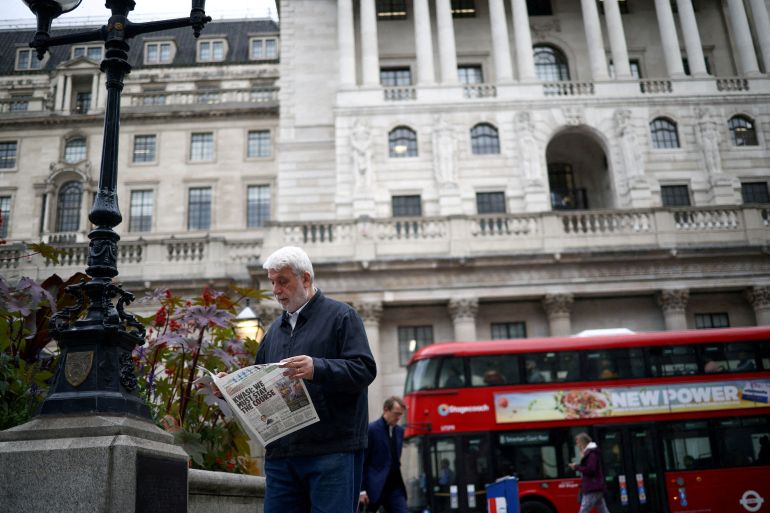UK central bank doubles size of bond buy-back to calm market
The Bank of England aims to calm the bond market and ease liquidity pressures that arose after the mini-budget announcement.

The Bank of England has moved to ease concerns about the expiry at the end of this week of its emergency programme to calm turmoil in the government bond market, including a doubling of the maximum size of its planned debt buy-back.
After finance minister Kwasi Kwarteng alarmed investors with a string of unfunded tax cuts last month, the central bank said on September 28 that it would temporarily buy up to 5 billion pounds ($5.5bn) a day of gilts with a maturity of at least 20 years.
Keep reading
list of 3 itemsIMF warns UK its budget cuts will ‘likely increase inequality’
UK stocks, sterling slip as BoE intervenes after IMF slams budget
So far, the BoE has bought far less than the minimum daily limit, but on Monday it said it was taking steps to ensure the scheme concludes smoothly.
“In the final week of operations, the Bank is announcing additional measures to support an orderly end of its purchase scheme,” it said in a statement.
The BoE has so far offered to buy up to 40 billion pounds ($44.2bn) worth of gilts but has only bought about 5 billion pounds ($5.5bn).
“The Bank is prepared to deploy this unused capacity to increase the maximum size of the remaining five auctions above the current level of up to 5 billion pounds in each auction,” the statement said.
Liquidity pressures
The maximum auction size would be set at up to 10 billion pounds ($11bn) in Monday’s operation although the central bank reserved the right to reduce offers.
The BoE also said it would launch a temporary expanded collateral repo facility to help banks ease liquidity pressures facing client funds caught up in the turmoil, which threatened pension funds.
The liquidity insurance operations would run beyond the end of this week and would accept a wider range of collateral than usual, including corporate bonds, the bank said.
In a third move, the BoE said it was prepared to support the further easing of liquidity pressures facing liability-driven investment funds (LDIs) through its regular Indexed Long Term Repo operations each Tuesday.
The sharp sell-off in British government bonds after Kwarteng’s “mini-budget” sparked a scramble for cash by Britain’s pension funds which had to post emergency collateral in LDIs.
Kwarteng said on Monday he would bring forward his medium-term fiscal plan, including an explanation of how the tax cuts will be paid for, to October 31 from November 23, with independent budget forecasts to be published the same day.
The earlier date will allow the BoE to understand the government’s tax and spending plans before it announces its next interest rate decision on November 3.
Antoine Bouvet, a strategist at the ING international bank, told Reuters news agency that low take-up of the BoE’s facility so far suggested that risk reduction by pension funds had been limited to date, and the central bank wanted to show it could deploy more support.
Yields on British 20- and 30-year gilts jumped by more than 10 basis points on Monday. They were still below their levels during the worst of the market rout triggered by Kwarteng’s mini-budget but were set to add to a recent run of daily increases.
“The closer we get to Friday the more gilts will sell off,” Bouvet said. “The bigger picture here is that the functioning of the gilt market is still impaired … Ultimately if we see another jump in volatility we could see the Bank step in.”